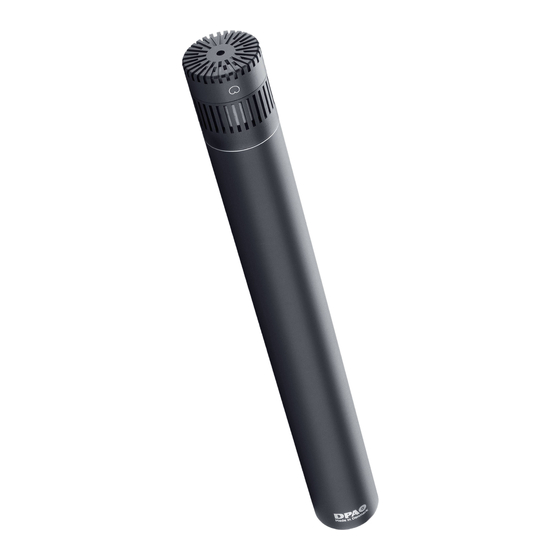DPA 3511 Руководство пользователя - Страница 2
Просмотреть онлайн или скачать pdf Руководство пользователя для Микрофон DPA 3511. DPA 3511 16 страниц. Cardioid and wide cardioid microphones
Также для DPA 3511: Руководство пользователя (16 страниц)

T E C H N I CAL D ESC RIPT I O N
The cartridge
Directional microphones Type 4011, 4012, 4015 and 4016 use a
19mm diameter prepolarized pressure gradient condenser- m i c ro-
phone car t r i d ge. Type 4011 and 4012 offer a f i rst order cardioid
pick-up pattern, the Type 4015 and 4016 offer a wide cardioid pat-
t e rn (see Fig. 1 & 2). The diaphragm is highly resistant to the most
a g gr e s s i ve kinds of humidity. The large spacing between th e
diaphragm and the back plate in this cart r i d ge makes the micro-
phone highly insensitive to temperature influence and allow s
greater SPL handling before clipping occurs.
Type 4011 and 4012 are designed to have a linear on-axis response
from 40Hz to 20kHz (±2dB) measured at 30cm (see Fig. 3). Type
4015 and 4016 are designed to have a linear on-axis response from
40Hz (±2dB) to 20kHz (+3/-1dB) measured at 60cm (see Fig. 4) and
are furthermore intentionally calibrated with a slight high-frequency
soft boost.
Great attention has also been paid to the microphone's off-axis
p e rf o rmance during the design process (see Fig. 3 & 4).
The diaphragm is protected from dust by an acoustically transparent
net behind the front protection grid and inside the back port of the
cartridge. For optimum s tability the microphone cartridge has
undergone a special pre-aging process, which s tabilizes all tensions
in the materials as well as the polarization voltage.
The preamplifiers
Types 4011 , 4012, 4015 and 4016 use the same high quality pres -
sure gradient capsule, but differ in their polar patterns and preampli-
fier powering systems. The 4011 and 4015 are 48V phantom pow-
ered, whereas the 4012 and 4016 are powered with 130V via the
DPA Type HMA4000 High-Voltage Microphone Amplifier.
The 401 1 and 4015 are powered via a s tandard P48 system and are
equipped with standard 3-pin XLR-connector (see Fig. 5 for pin
designation). They feature a 20 dB attenuator push-switch built into
the connector (see Fig. 6). When the button is pushed in, the output
is attenuated 20 dB. The attenuation allows the microphones to be
used for close-miking high SPL sound sources without overloading
the console input amplifier from the output of the microphone.
2
